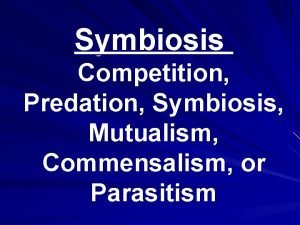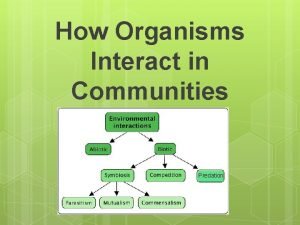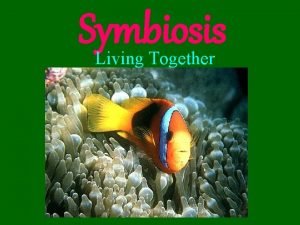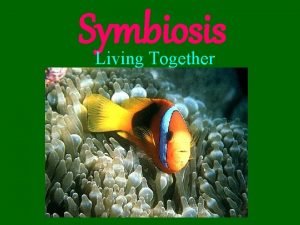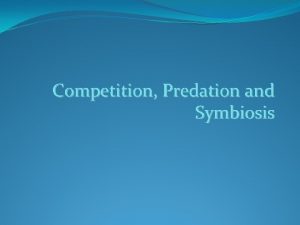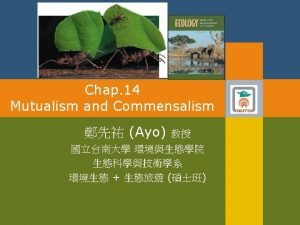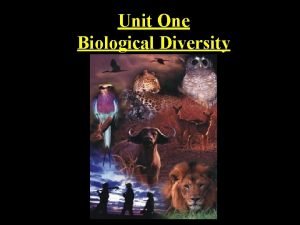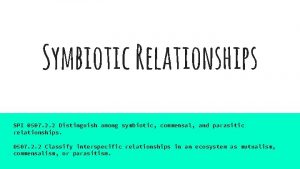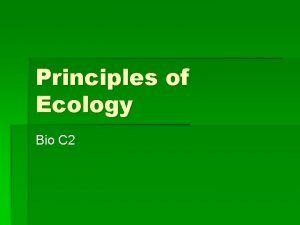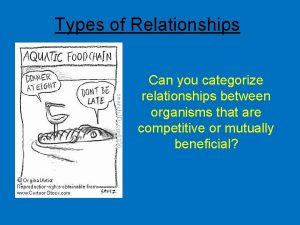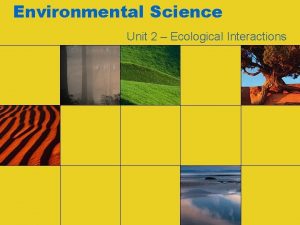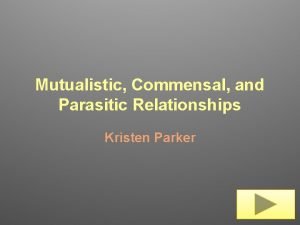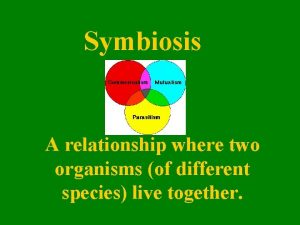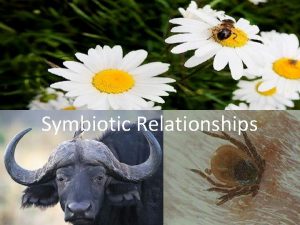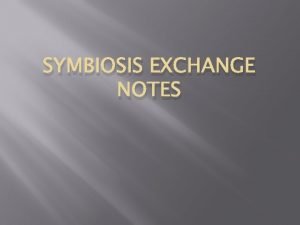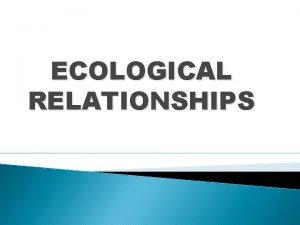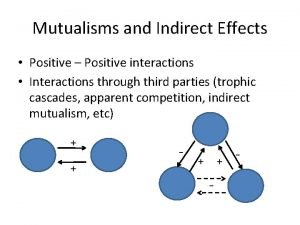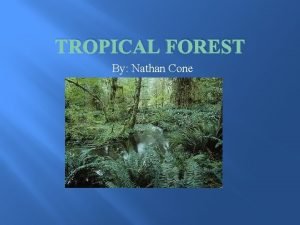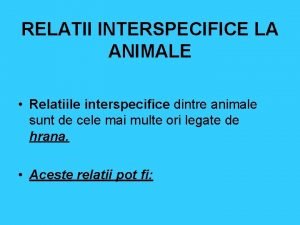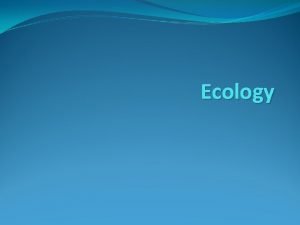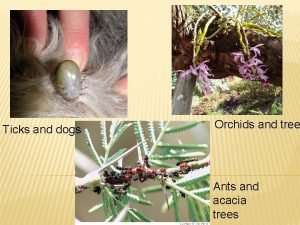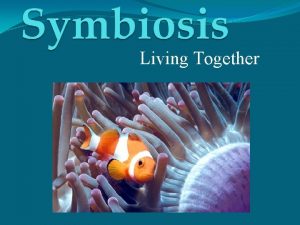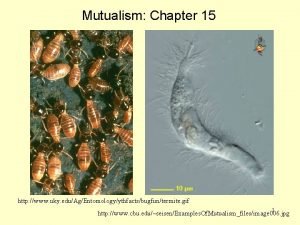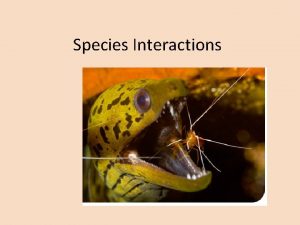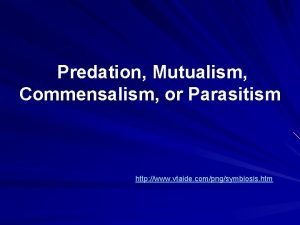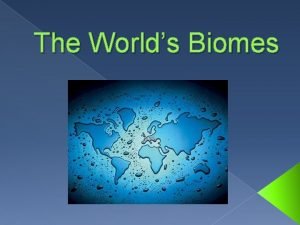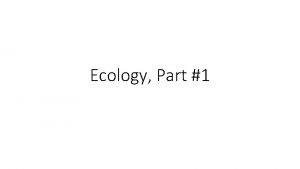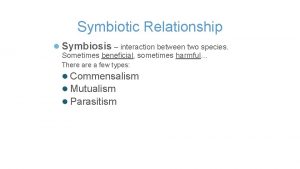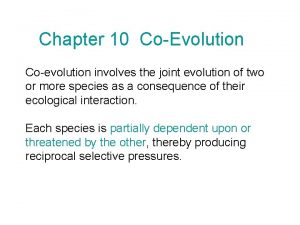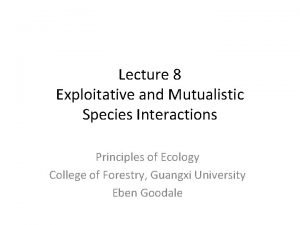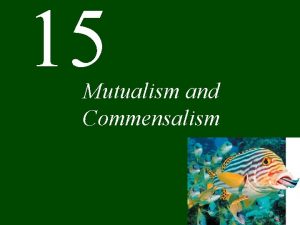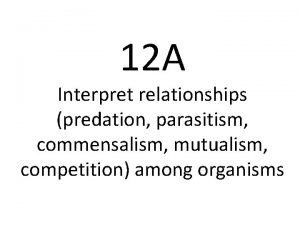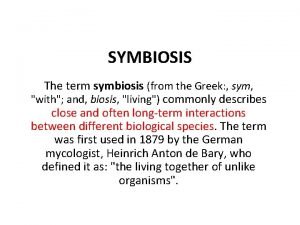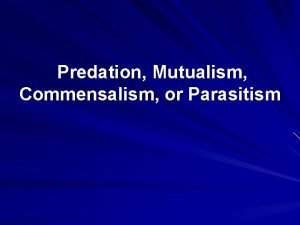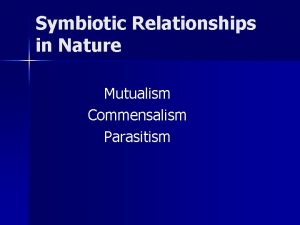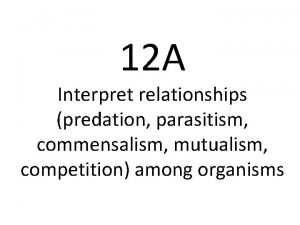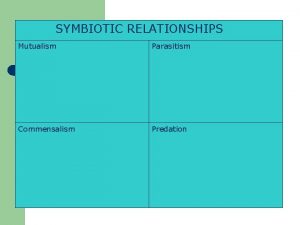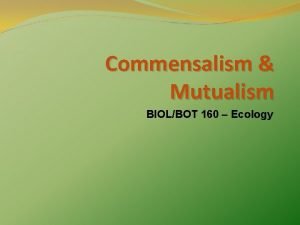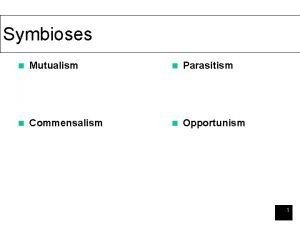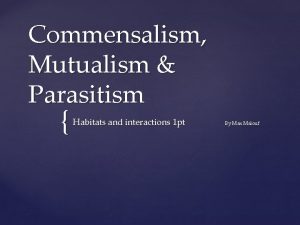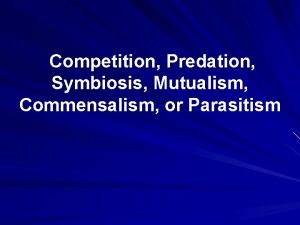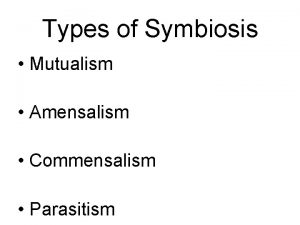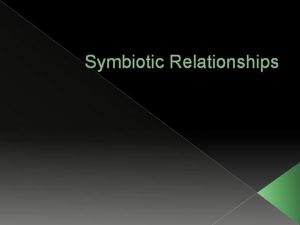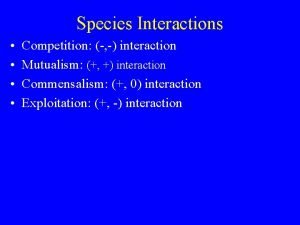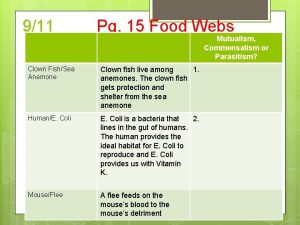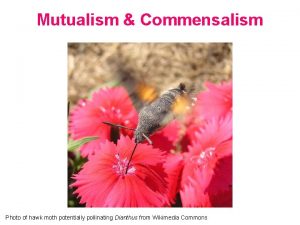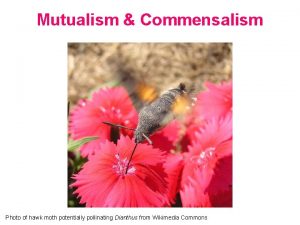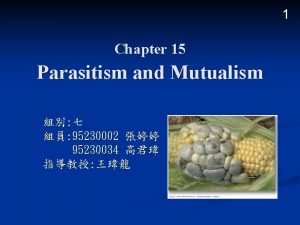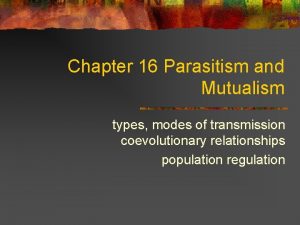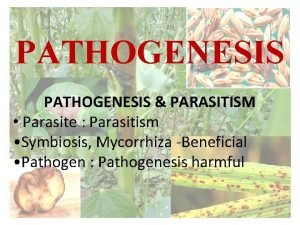Mutualism Commensalism Parasitism Relationships in Ecosystems Today we







































- Slides: 39

Mutualism Commensalism Parasitism

Relationships in Ecosystems - Today we will look at how organisms interact with each other in ecosystems

Symbiosis • Symbiosis is a close and permanent relationship between two organisms. • Symbiosis means living together. There are three kinds of symbiosis: mutualism, commensalism, and parasitism.

1. Mutualism + + • Mutualism is a symbiotic relationship in which both species benefit. This little fish is helping me by cleaning my teeth!!! Yeah!!! I’m eating the big fish’s food so he’s helping me too! Yeah!!!

More Examples of Mutualism ++ The coral reef and the algae exist in a mutualistic relationship. They supply food and shelter for each other.

Mutualism and Lichens! ++ Lichens are made up of fungi and algae. The fungi attaches the organism to the tree and protects the algae. The algae provides food through photosynthesis.

Mutualism and flowers! ++ Flowers provide food for insects. Insects spread the seeds of flowers. Both organisms benefit!

2. Commensalism + 0 Commensalism is a symbiotic relationship in which one species benefits and the other species is neither harmed nor benefited. In this picture, Spanish moss is growing on the trees. The moss benefits because it has a place to live, and the tree doesn’t care.

More examples of Commensalism +0 Clownfish hide in poisonous sea anemones which protect them from larger fish. The clownfish benefit, and nothing happens to the sea anemones.

Commensalism continued… +0 This bird, called an egret rides on the back of large mammals like elephants. The egret benefits because it gets a place to live, and the elephant doesn’t care because it does not benefit or become harmed by the relationship.

3. Parasitism + Some interactions are harmful to one species, yet beneficial to another. Parasitism is a symbiotic relationship in which a member of one species benefits and the other species is harmed is called parasitism.

Parasitism + • Parasites have evolved in such a way that they harm, but usually do not kill the host species. Tapeworms are parasites. They attach to your intestines and suck out all of your food. The tapeworm benefits, and the host is harmed because they slowly starve to death. One of the ways to get rid of a tapeworm is to starve yourself and then place a piece of meat in front of your mouth. The tapeworm will smell the meat and climb up your throat and out of your mouth.

Tapeworms continued!!!

Other parasites! A lungworm benefits while it harms the host. This is the head of a parasite. Parasites often grab on to the digestive tracts (intestines and stomachs) of their hosts.

Guinea Worm-Another parasite!

Let’s recall… Mutualism Commensalism Parasitism both organisms benefit one organism benefits one organism is unaffected one organism benefits one organism is harmed

Community Interactions Predation Some organisms (predators), consume others (prey)

Predation is when one animal eats another animal. It is not a type of symbiosis, but it is an interaction between organisms. A predator is a type of consumer. Predators seek out and eat other organisms. The organisms the predators eat are called prey. Predator Prey

Predation The killer whale swims beneath the seals and then goes up towards the surface, scooping part of the seal in its mouth.

• Predation is found in all ecosystems and includes organisms that eat plants and animals. • The animals that predators eat are called prey.

Impact of Predation • How does the PREDATOR/ prey relationship affect POPULATION ? – If the number of prey in a POPULATION increases then the number of PREDATORS will also increase. – If the number of PREDATORS decreases, then the number of prey will INCREASE.

Organisms Interact in Different Ways • Organisms may cooperate, compete, or depend on each other for survival • Predator and Prey relationships – Predators can affect how the prey populations are distributed (fish in large groups) – Prey can affect the location and number in predator populations (birds feeding on insects migrate to the areas where the insects are plentiful)

Predator Prey Relationship Graph

Competition Organisms in a population compete with each other food, water and mates. Competition increases when these things aren’t available.

Organisms Interact in Different Ways • Competition – Competition is the struggle between individuals or different populations for a limited resource http: //cache. eb. com/eb/image? id=95240&rend. Type. Id=4

Competition • What is. COMPETITION? – When species within an ECOSYSTEM compete for the same RESOURCES. – Organisms in an ECOSYSTEM compete for: • FOOD • WATER • SPACE – Example: In the ocean, dolphins, whales and large fish all compete for smaller fish.

– Competition can happen with the same species (plants compete for light, space, and nutrients) – Competition between different species (hyenas and vultures compete for remains of dead animals) http: //www. duiops. net/seresvivos/galeria/hienas/hyena-and-whitebacked-vultures-01301147 b. jpg

Red Deer (Competition) During mating season, red deer males will get in many fights to be considered the best male for the females to mate.

Organisms Interact in Different Ways Cooperation • • Some organisms work together to benefit each other – Killer whales hunt in pods (groups) – Ants, bees, and termites (members of a colony have different roles and responsibilities…queen bee, worker bees, etc. ) http: //www. apitherapy. com. au/contents/media/l_bee%20 pollen%20 dw. jpg

Ants! (Cooperation) Despite having different jobs, all ants work together for the good of their colony.

What kind of interaction? You will see real life examples of the interactions addressed in the powerpoint.

Honey bees have specific roles to complete for the success of the colony. What interaction is this? cooperation

Boxer Crab & Anemones This Boxer Crab carries a pair of stinging anemones in its claws, which it uses to defend itself from predators. The anemones get to move around which increases their food supply. What interaction is this? mutualism

Emperor Shrimp & Sea Cucumber This tiny emperor shrimp is riding along on the back of a sea cucumber (a long wormlike starfish relative) while it crawls along a sandy bottom. The shrimp gets to travel around under the protection of its much larger partner, and the sea cucumber doesn't seem to mind. What interaction is this? commensalism

The Purple Sea Star The purple sea star consistently feeds on the barnacles that are the greatest number. They all feed on the same type of barnacles. What interaction is this? competition

Cattle & Cattle Egrets As these cattle walk around eating grass they stir up lots of insects. The egrets hang around and get a yummy meal of insects. commensalism What interaction is this?

Antelope & Ox Bird This ox bird hangs out on the antelope and gets a delicious meal of bugs living on the antelope. The antelope gets rid of parasites. What interaction is this? mutualism

Dragonflies and mosquitoes predation Dragonflies eat mosquito larvae and fully mature mosquitoes. What interaction is this?

Goby and Alpheid Shrimp This alpheid shrimp (on the right) uses its strong claws like a bulldozer to create a burrow in the sand. The shrimp is nearly blind. It relies upon its partner, the sharp-eyed goby, to warn of danger. When a potential predator approaches, both animals disappear quickly into the burrow. mutualism What interaction is this?
 Symbiosis competition
Symbiosis competition Example of coevolution
Example of coevolution Mutualism
Mutualism Types of symbiosis
Types of symbiosis Parasitism
Parasitism Mutualism vs commensalism
Mutualism vs commensalism Commensalism and mutualism difference
Commensalism and mutualism difference Difference between commensalism and mutualism
Difference between commensalism and mutualism Commensalism and mutualism
Commensalism and mutualism Categorize each relationship as mutualism or parasitism.
Categorize each relationship as mutualism or parasitism. Compare and contrast mutualism and parasitism
Compare and contrast mutualism and parasitism Commensalism and parasitism
Commensalism and parasitism Parasitism sample
Parasitism sample Symbiotic relationship commensalism examples
Symbiotic relationship commensalism examples Examples of commensalism
Examples of commensalism Today's class will be at
Today's class will be at Today's lesson or today lesson
Today's lesson or today lesson Meeting objective
Meeting objective Characteristic of fingerprint
Characteristic of fingerprint Today meeting or today's meeting
Today meeting or today's meeting Today's lesson or today lesson
Today's lesson or today lesson What is multualism
What is multualism Mutualism
Mutualism Indirect interaction example
Indirect interaction example In the rainforest
In the rainforest Relatii intre vietuitoare
Relatii intre vietuitoare Biosphere ecology definition
Biosphere ecology definition Symbiosis orchid and a tree
Symbiosis orchid and a tree Parasitism
Parasitism Mutualism gif
Mutualism gif Mutualism
Mutualism Vtaide
Vtaide Mutualism examples
Mutualism examples How do limited resources affect a population?
How do limited resources affect a population? Mutualism
Mutualism Mutualism crocodile and bird
Mutualism crocodile and bird Mutualism
Mutualism Mutualism characteristics
Mutualism characteristics Parasitism
Parasitism Greek sym
Greek sym
